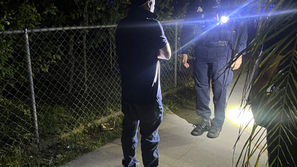Two Buck Chuck & The Marlboro Man
- Bill Coate
- Jun 22, 2019
- 4 min read

For The Madera Tribune
Frank Bergon is shown here at a book signing in Madera.
Frank Bergon opens up the real West
Not since historian Frederick Jackson Turner declared in 1893 that the frontier no longer existed, has a writer grasped the essence of the American West like Frank Bergon in his new book, “Two Buck Chuck & the Marlboro Man.”
The widely acclaimed author who grew up on his family ranch in Madera County and graduated from St. Joachim’s School is returning to his roots in August with his latest book, which is set in the Central San Joaquin Valley.
Bergon uses characters that most Valley residents know to illustrate how the Old West has met the New West to produce the Real West right here in the Central Valley.
Just as Turner looked at the West 125 years ago and saw rugged individualism, mobility, self-sufficiency, resourcefulness, and a propensity toward wastefulness in its people, Bergon sees the same characteristics today, but he sees something else. He may not come right out and say it, but he sees it.
Today Bergon sees in the real West an abiding drive for freedom in all of the characters he surveys.
Beginning with Fred Franzia, the irreverent thorn in the side of the snooty Napa Valley vintners, Bergon describes his friend’s “anti-elitist battles” for freedom from the “hypocrites” of the wine industry. He tells how Fred, with his brother and a cousin, started the Bronco Wine Company after his father and uncles sold the family winery to Coca-Cola. Fred became the largest wine grower in the country and the owner of the fourth biggest winery — all really in the demand for freedom. He would do it his way.
Likewise, Sal Arriola — Bergon dovetails Sal’s story into Franzia’s. It was the search for freedom that turned the “illegal immigrant” into a Valley farmer. After a standout academic and athletic career at Madera High School, Sal earned a degree in business economics from UC Santa Barbara. Determined to find real freedom in agriculture, Sal became Fred Franzia’s Chief Agricultural Officer at $95,000 per year.
Next, Bergon turns to Mitch Lasgoity, the Basque rancher who began with 320 acres and found freedom in buying dirt. Before he was through, he had 33,000 acres and farmed “every inch of it” with his daughter Michelle and son John.
When Bergon moved to Clay and Dusty Daulton and the Daulton Ranch, the story of the West took a more somber tone. The water crisis that just won’t go away, no matter how much rain falls, took center stage. Talk turned to what Marc Reisner, in Cadillac Desert called “the suicidal habit of mining groundwater, the pumping of nonrenewable fossil water.” Clay suggested the water situation may not be a disaster right now, but it does represent a serious “diminishment.”
Still, he and Dusty continue on that foothill ranch that his great-great-grandfather and namesake established over 160 years ago. Where else could they go to find freedom?
Just as living off the land held out the promise of freedom for those who worked the dirt in the Central Valley, so did Bergon find that a sense of ethnic tolerance offered a measure of freedom in the new, real West.
In the same year that Dr. Albert Wilburn, an African-American student at Madera High, was class valedictorian, student body president, and Northern California Scholarship Federation Student of the Year, the rest of the country was experiencing freedom rides, lunch-counter sit-ins, and the Birmingham church bombings.
Dr. Wilburn told the story of how his aged father would go to Courthouse Park in Madera — because, unlike his home in the South, he was allowed to — he found freedom in the West.
Not every Black person saw things as Dr. Wilburn saw them, however. Nancy Turner, who was reared on a ranch in Madera and went to school with Wilburn thought Madera was racist in a strange sort of way. The former social worker and parole agent saw an “overlay of racism existing simultaneously with tolerance in the schools. ‘There was racism, but we weren’t aware of it…’”
Madera High alumnus Joe Alvarez didn’t experience discrimination until he left Madera for the Navy. Irene Waltz found her freedom through her Native American spirituality, and Louis Owens found his when he was able to finally escape his poverty stricken, Native American Okie past.
Bergon concludes his book with a look at “Marlboro Country,” the real Marlboro Man, Darrell Winfield, and some of those who tried to impersonate him.
Dispensing with Claude Dallas, the killer who tried to mimic the “legendary, freedom-loving, self-sufficient cowboy who tamed the West,” Bergon takes his reader on a journey with the real deal — the Marlboro Man.
Bergon first met Winfield in Madera in 1962, six years before he became the Marlboro Man. He maintained a friendship with Winfield until his death in 1985.
Frank Bergon is arguably the most highly acclaimed author and scholar to come from Madera County. After graduating from a preparatory school in San Jose, he got his Bachelor’s degree from Boston College. Bergon was a Wallace Stagner Fellow at Stanford University and earned his Ph.D. in English and American Literature at Harvard. He taught at Vassar for more than 35 years.
Bergon is the author or editor of eleven books.
























Comments